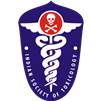Analytical study involving Neuroparalytic-snake Envenomation cases reported to a North Indian tertiary care Hospital
Keywords:
snake bite; neuroparalysis; antivenom; neostigmine; mechanical ventilation.Abstract
Aims: To study the clinical profile of neuroparalytic snake envenomation in a tertiary care referral north Indian hospital.
Material & methods: Retrospective analysis of neuroparalytic snakebite cases admitted to the ICU (A&E) PGIMS, Rohtak from Jan 2010 to Dec 2014.
Results: Out of total 185 cases of snakebite there were 183 elapid bites with neuroparalytic symptoms and 2 viper bites having haemostatic abnormalities. 65% of cases of snakebite occurred when the patients were asleep. Urban to rural ratio was 1: 2.8 and male to female ratio was 3.1:1 .Median time to arrival at hospital was eight hours. 78.1 % of all elapid bites required mechanical ventilation (MV). Mean duration of MV was 3.8 ± 1.79 days. 21 of 178 patients who received antivenom had an adverse event. The average dose of antivenom was 25.3 ± 0.93 vials. There was no beneficial effect of giving neostigmine. Overall mortality rate was 6%.
Conclusion: Snakebite should be considered in all early morning myasthenic presentation and in patients coming in rainy season with respiratory failure with no prior symptoms. Ventilatory support along with anti-snake venom is life-saving. Significant side effects are seen with anti-snake venom, therefore it should be given under strict monitoring. Mortality due to snakebite depends on time delay in presentation and pretreatment cardiopulmonary arrest and sensitivity to anti-snake venom. There is an urgent need to educate rural population about the hazards and treatment of snakebite. Availability of antivenom at primary health centers and rapid transport facilities may decrease the morbidity with snakebites



